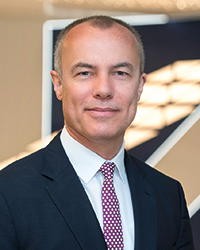

- Eleanor Hill
- Editorial Consultant, Treasury Management International (TMI)

- Lothar Meenen
- Global Head of CCM Sales, Lending & CBNL, Regional Head of CCM EMEA and Regional Head of CCM Germany, Deutsche Bank
As the possibilities of real-time treasury become clear and the era of open banking begins, TMI’s Editor, Eleanor Hill, interviews Lothar Meenen, Global Head of Corporate Cash Management Sales at Deutsche Bank, to discuss how treasury departments will need to continue to evolve.
Eleanor Hill: Over the past decade, a barrage of regulatory changes, together with centralisation and efficiency projects handed down by head office have left ever-leaner treasury teams with very little room for manoeuvre. Do you think reactivity has had to be the order of the day?
Lothar Meenen: Yes, and I believe it is now time for treasurers to put themselves back in the driving seat. Thanks to exciting developments in technology, as well as innovations in the banking and payments landscape, today’s treasurers have an opportunity build the treasury of tomorrow, while cementing the department’s ongoing importance to the organisation. Achieving this, however, will require treasurers to step outside their traditional comfort zone.
Survival of the fittest
EH: And do you think that some serious misconceptions will also need to be addressed along the way? Not least the fear that there is no future for the treasury department, or that the treasurer’s role will soon become obsolete.
LM: That’s right - in reality, as long as the treasury department remains fit for purpose, it will always be needed. Nevertheless, the ways in which the treasurer achieves the highest level of visibility - and gains the best possible control - over the company’s cash will change, as will the treasurer’s remit.
As technology evolves, the speed of business is increasing, the value of real-time data is growing, and the role of the treasurer must develop accordingly. Treasury will no longer be about managing end-of-day cash positions. As clichéd as it may sound, the treasurer must go beyond his or her ‘mechanical’ role and become a true strategic partner to the business.
EH: Can you give a few examples?
LM: I think it is important to stay on top of the latest market developments, identify how innovations could improve treasury and benefit the wider business going forward, and thereby being able to successfully pitch those ideas to the board. After all, it is important to bring ‘need to know’ information to the table, but why not bring ‘good to know’ information as well?
Naturally, no treasurer can invest time and effort in every new initiative, and it will be important to prioritise which are truly relevant to the business. But some core developments are happening that all treasurers looking to remain relevant to the organisation must embrace.
Spotting tomorrow’s trends
EH: Which developments in particular would you call out?
LM: Real-time and instant payment schemes for example are quickly becoming a global phenomenon. SCT Inst is also now up and running across the Eurozone – enabling up to €15,000 to be credited to a beneficiary’s account in under 10 seconds. Today, a number of corporates are still finding it tough to make the business case for embracing real-time payments. Typical reasons for a lack of interest in these schemes include the relatively low payment thresholds currently in place, and the impression that instant payments are somehow more exciting for consumers than corporates.
But if consumers are interested in instant payments, then corporates should be too. B2C organisations in particular need to ensure that their customers can pay them when and how they want. If not, they risk losing a significant proportion of their customer base to competitors who do offer the latest payment functionalities. Moreover, payment limits on real-time schemes are only likely to increase, making them more and more relevant for B2B treasurers too.
The move towards real-time payments also signals a broader move towards real-time treasury. Treasurers will need to be able to apply and reconcile funds that come in 24/7/365, which will require greater automation. This will also completely change the face of cash visibility, since end-of-day positions will become a thing of the past. Instead, real-time data will lead to live cash positions and far more dynamic cash flow forecasting. If treasurers can successfully adapt their processes to this new model, they will become more relevant than ever.
Open banking brings change
EH: Anything else that is top of mind at the start of 2018?
LM: The advent of open banking on the back of PSD2, which went live on 13 January 2018, is another potential game-changer – but one that is currently being overlooked by many treasurers, largely because it is still new and perhaps misunderstood.
On the surface, PSD2 seems as though it will mainly impact the banking and payment services provider (PSP) landscape. Dig a little deeper, however, and there are potential opportunities for treasurers too.
A relatively simple example is that open banking and the use of APIs will enable efficient aggregation of multi-bank data for those businesses that do not have the budget for SWIFT for Corporates. However, the possibilities are far more extensive – and as open banking matures over the next 12-18 months, forward-thinking corporates will be able to realise significant cost efficiencies or even unlock new revenue pockets.
#TomorrowsTreasury
Keeping up-to-date with the latest treasury solutions, digital innovations and market developments is clearly vital.
Deutsche Bank has therefore launched a new web app that explores how today’s treasury responsibilities will be affected in the world of tomorrow – and how treasurers can not only meet, but exceed, future expectations.
To discover more visit: db.com/cm
Leap of faith
EH: Do you think all treasury departments are ready for these technological changes? Or is the prospect of making payments via an API too alien?
LM: Trust in technology will be vital in tomorrow’s treasury function, as will the inclusion of digital natives, not just digital immigrants, in the treasury team. Technology is changing, as are digital channels, providers and partnerships.
EH: So should treasurers work with more fintechs?
LM: I would say they should question their existing mindset, rather than instinctively fear change. In fact, fintechs are increasingly partnering with banks to grow the reach of their products, as well as their standing among the corporate community. Treasurers should take comfort from this, and feel confident in the ability of new technologies, tech companies, and innovative banks, to make their working lives easier by enabling them to do more with less.
EH: Is there anything they should fear? Hackers?
LM: Certainly cyber security will be ever-more important in tomorrow’s treasury function, and the traditional notion of ‘control’ over the company’s cash will extend to cybersecurity. Failing to have the right controls in place will no longer be an acceptable reason for letting a fraudulent payment slip through. Treasury must be able to demonstrate that it is doing its utmost to protect the company’s cash from all types of attack.
The human touch
EH: Can technology help here too?
LM: Treasurers and their teams will need be to be hypervigilant, and call more on internal and external partners to assist them – from the IT department to tech vendors and banking partners. However, even in this digital age, human relationships and effective communication will continue to be two of the treasurer’s strongest weapons.
Strategic partner to the business
EH: What other traits do you believe tomorrow’s treasurer will need to have?
LM: The ability to command the attention of the CFO and other major stakeholders will continue to be vital for establishing treasury priorities and seizing new business opportunities. This is precisely why being a strategic partner to the wider organisation will be so important for treasurers in the years ahead. Added value will soon become a new corporate currency, and treasurers will want to position themselves as the first people to speak to when management are making critical business decisions.
Of course, this will take time and perseverance. But the sooner treasurers start demonstrating additional value to the C-suite, and preparing for the new digital ecosystem, the sooner they will be able to reap the benefits.
Lothar Meenen
Global Head of CCM Sales, Lending & CBNL, Regional Head of CCM EMEA and Regional Head of CCM Germany, Deutsche Bank
Lothar Meenen, Managing Director of Deutsche Bank, has more than 35 years of banking experience, primarily in coverage functions of multinational clients.
Before his recent appointment, Lothar held many prominent management roles within the firm. From 2007 until 2010, he was Head of Structured Trade & Export Finance for Germany and Eastern Europe including Russia. Since January 2013, he has headed Trade Finance and Cash Management Corporates Germany in addition to being Chairman for the Global Cash Lending Council.
As of February 2017, Lothar has been responsible for driving sales within the newly formed Corporate Cash Management division of GTB, where he has been appointed as Global Head of Corporate Cash Management Sales, Lending & CBNL, as well as his simultaneous appointment as Regional Head of Cash EMEA including Germany for all functions.



